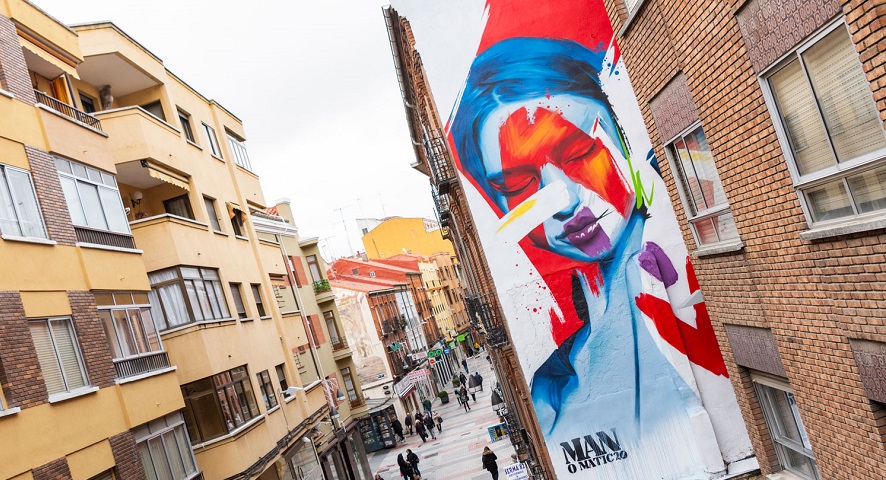Lugares - Arte urbano - Don Juan Tenorio, embozado
Breadcrumb
Breadcrumbs
Asset Publisher
Mural Art Route

Valladolid embraces urban art to reclaim forgotten corners of public spaces, creating a friendly city for its residents and an appealing destination for tourism.
Following in the footsteps of cities like Berlin, New York, and London, Valladolid started a grant program in 2016 to encourage local artists to decorate plain walls and facades, transforming them into genuine works of art.
Since 2019, the City Council and the association Andén 47 have collaborated closely, united by the goal of revitalizing the urban space through art. The project, renamed as the 'Vertical District,' maintains an ongoing call for property owners and community associations to offer their buildings as canvases (registrations can be made at distritovertical.org).
Mural Art Route: • Mantería Street, crossing with Simón Aranda Street - Mural by Gonzalo Borondo.
• Mantería Street - 'Khanya, Bearer of Light and Fire' mural from the Identity series by Manomatic, chosen by Widewalls portal as one of the best in 2020.
• Mantería Street, Simón Aranda Street 1 and 13, and Cervantes Theater - 'Cinco muñecos a pie de calle' by Kapone.
• López Gómez Street 24 - 'Mirar al futuro con alas de libertad, igualdad y respeto' by Eva Mena.
• Ricote Alley (Plaza Mayor, entrance of Pasión Street) - 'Time' by Clockers Colletive (David Fresno and Gonzalo de Miguel).
• Las Moreras Beach - Beach scenes by Inés García Candau.
• Gondomar Street, corner of Casa del Sol - 'Vera Fauna' by María Ruíz (Maru Rz).
• Estudios Street, next to Casa de Colón and Magdalena Church - 'Children's Paradyse. The Peak' by Henar Bayón.
• Estudios Street 10 - 'Estudio en la calle' by Daniel Muñoz.
• Casa del Estudiante (Calle Real de Burgos) - 'Two likes, one comment' by Javier Román.
• Gabilondo Street - Mural by Negro Maravilla.
• Porvenir Street - 'El selfie' by Diego Vicente, and 'El porvenir se define hoy' by Reskate.
• Surroundings of Arco de Ladrillo - Murals by Chais Martín and Rubén Cassasola.
• Arco de Ladrillo Bridge - Mural by Cuco / Javier Carrera.
• Golondrina Street - Mural by Sukha and Yksuhc in collaboration with the Pajarillos Educa project.
• Labradores Street tunnel - Intervention by students from the School of Art.
• Bailarín Vicente Escudero Civic Center (Vadillos) - 'El bailarín y la bailarina' by Javier Carreras 'Cuco'.
• San Pedro Regalado Sports Complex - 'Salida de emergencia' by DosJotas.
• Jardines del Parque Güell Street - Mural by Ruben Viard.
• Costa Dorada Street (Barrio España) - 'El éxodo rural y la pérdida de identidad, o cómo progresar sin perder las raíces' by Taquen.
• Montaña Street (Barrio España) - 'Autorización, nueva normalidad y horizonte' by Ampparito.
• Tierra de Campos Street (Barrio España) - Mural by Corte.
• CEARCAL (Valle de Arán Street, Barrio España) - 'Fortuna que canta, siempre se la lleva el aire'. Tribute to Zorrilla by FOACAL students.
• Cordillera Street with Santander Street (Barrio España) - 'Postales de barrio' by PincelArt Olid association.
• Pillars of the viaduct on Zamora Avenue, passing through Rueda Road - Futuristic murals by Nieves Peral and Javier Carrera, and 'Mr. Pain' mural by El Artista Polímata.
Navigation Menu
Asset Publisher
LOCATION
Widget tiempo Valladolid
Información turística
Tourist Office on Acera de Recoletos
Open Monday to Saturday from 9:30 a.m. to 2 p.m. and from 4 p.m. to 7 p.m. Sundays, from 9:30 a.m. to 2 p.m.
Phone: 983 21 93 10
Tourist Office on San Benito, Calle de San Benito s/n
Open Monday to Saturday from 10 a.m. to 2 p.m. and from 4 p.m. to 7 p.m. Sundays, from 10 a.m. to 2 p.m.
Phone: 983 42 61 93
Tourist Information Point at the Train Station
Open Tuesday to Saturday from 10 a.m. to 2 p.m. and from 4 p.m. to 7 p.m. Sundays, from 10 a.m. to 2 p.m.
Phone: 983 42 60 30
Media Gallery
Valladolid seen through the eyes of its inhabitants and tourists
estatua don juan tenorio 2.jpg
estatua don juan tenorio 2.jpgestatua don juan tenorio.jpg
estatua don juan tenorio.jpgestatua don juan tenorio 2.jpg
estatua don juan tenorio 2.jpgestatua don juan tenorio.jpg
estatua don juan tenorio.jpgAsset Publisher
Don Juan Tenorio, embozado
 '"Don Juan Tenorio, embozado" is a sculpture created by the Valladolid sculptor and image-maker Miguel Ángel Tapia. It pays tribute to the most remembered character of Valladolid poet José Zorrilla. The statue is located on Fray Luis de Granada Street, next to the entrance of the romantic garden of the writer's birthplace.
'"Don Juan Tenorio, embozado" is a sculpture created by the Valladolid sculptor and image-maker Miguel Ángel Tapia. It pays tribute to the most remembered character of Valladolid poet José Zorrilla. The statue is located on Fray Luis de Granada Street, next to the entrance of the romantic garden of the writer's birthplace.Made of life-sized bronze, it depicts the figure of the knight Don Juan Tenorio in a lurking attitude. The original sculpture is equipped with a sensor that, when activated by movement, triggers a voice recording with Don Juan uttering the popular phrase, "¡Alto! ¡Quién va!" ("Halt! Who goes there?"), which is characteristic of the speech of Spanish knights in the 16th century, the era in which the play is set. These words are also spoken by the character in the first part of Zorrilla's drama when he encounters Don Luis Mejía near the house of Doña Ana de Pantoja, Mejía's promised bride and the target of Juan's dubious bet with his friend.
